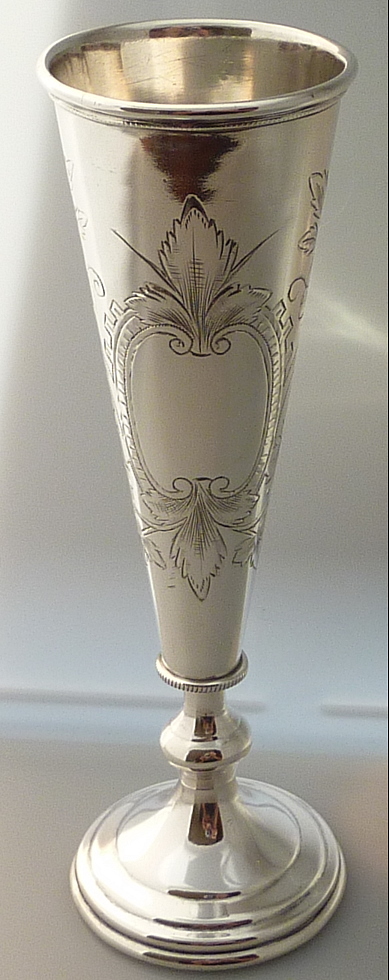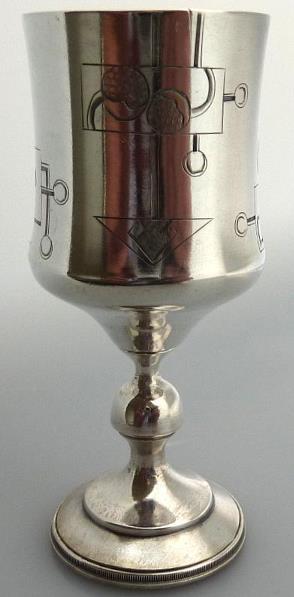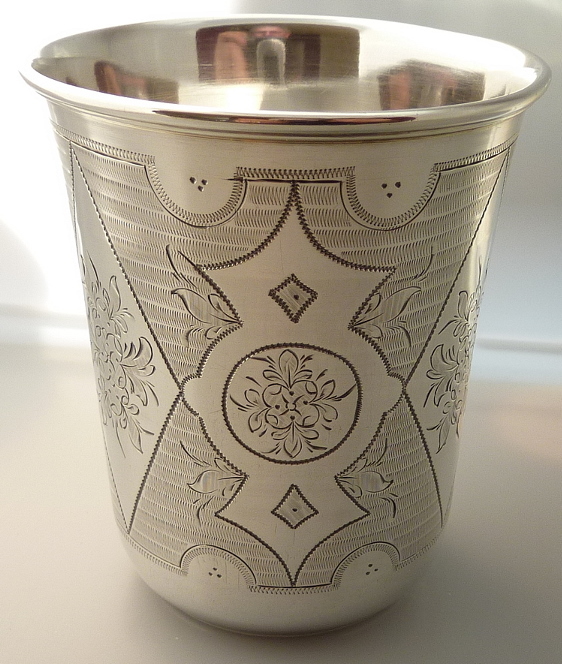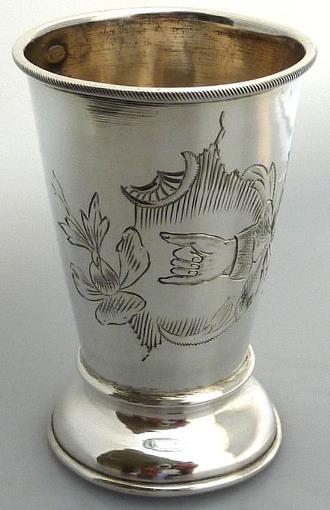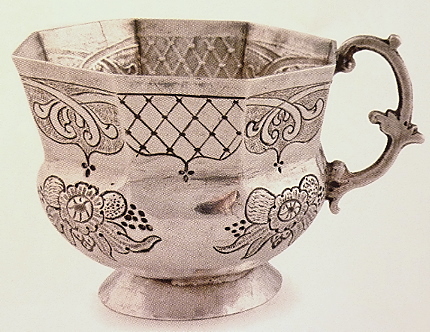
1871 Kiddush Cup
1871 Kiddush Cup
I have an idea of who the maker, assayer and etc are from the hallmark indexes on this site, but an expert identification would be very much appreciated.


Re: 1871 Kiddush Cup
Hi silverly -
the maker of this stopka (Kiddush cup is pure nonsens - again and again told from stupid dealers to stupid customers!) is Dmitriew Michail, 1854-1877.
Regards
Zolotnik
the maker of this stopka (Kiddush cup is pure nonsens - again and again told from stupid dealers to stupid customers!) is Dmitriew Michail, 1854-1877.
Regards
Zolotnik
Re: 1871 Kiddush Cup
Hi Silverly,
Is it an illusion, or are the hallmarks struck prior to the maker's mark being struck?
Trev.
Is it an illusion, or are the hallmarks struck prior to the maker's mark being struck?
Trev.
Re: 1871 Kiddush Cup
Thank you Zolotnik. Kiddush cup was the term used by the American jewish gentleman that sold the cup to me. I'm sure he didn't intend to disguise it's name. His price was tied to this "stopka's' scrap value.
Is there a way to distinguish a stopka from other similar cups?
Is there a way to distinguish a stopka from other similar cups?
Re: 1871 Kiddush Cup
Hi silverly -
of course is there a way to distinguish a stopka (shotglass) from a rjumka (shotglass with a foot) or stakan (beaker): form, size and use. There are several more other drinking vessels (tscharka, kovsh etc).
STOPKA




RJUMKA




STAKAN




Regards
Zolotnik
of course is there a way to distinguish a stopka (shotglass) from a rjumka (shotglass with a foot) or stakan (beaker): form, size and use. There are several more other drinking vessels (tscharka, kovsh etc).
STOPKA




RJUMKA




STAKAN




Regards
Zolotnik
Re: 1871 Kiddush Cup
Hi Trev,
There is no question that the makers mark was done after the hallmark. It doesn't show up well in the image, but the rectangular cartouche for the maker's mark overlaps the hallmark.
Pat
There is no question that the makers mark was done after the hallmark. It doesn't show up well in the image, but the rectangular cartouche for the maker's mark overlaps the hallmark.
Pat
Re: 1871 Kiddush Cup
Zolotnik,
I shall have to remain in my stupor when it comes to properly identifying these cups, but I will say that those are beautiful examples you have shown. Great images.
Thank you,
Pat
I shall have to remain in my stupor when it comes to properly identifying these cups, but I will say that those are beautiful examples you have shown. Great images.
Thank you,
Pat
Re: 1871 Kiddush Cup
Yes the maker's mark is struck after the assaying marks. That is always an alarming sign. According to the Russian law it was strictly forbidden for the assayer to struck his mark on an unmarked object. There are, however, two possible explanations why the maker's mark is on the assaying mark:
1. It is an imported item brought by the Russian customs to the assaying office to be tested, approved and marked. Then the importer has struck his (retailer) mark on the object. This was not an unusual procedure. In 1871 there were no special import marks used.
or
2. It is a spurious object.
Zolotnik is right in calling it "stopka" rather than "kiddush cup". Dealers prefer to call them "kiddush cups" because it sounds more fancier and attracts more customers as well as the price can be put higher. Judaica objects are currently popular collecting objects. The most of such cups are ordinary Russian vodka cups (stopkas) only.
1. It is an imported item brought by the Russian customs to the assaying office to be tested, approved and marked. Then the importer has struck his (retailer) mark on the object. This was not an unusual procedure. In 1871 there were no special import marks used.
or
2. It is a spurious object.
Zolotnik is right in calling it "stopka" rather than "kiddush cup". Dealers prefer to call them "kiddush cups" because it sounds more fancier and attracts more customers as well as the price can be put higher. Judaica objects are currently popular collecting objects. The most of such cups are ordinary Russian vodka cups (stopkas) only.
Re: 1871 Kiddush Cup
Hi all,
Just a thought, but the stopka appears to also have a makers mark on the rim as shown in picture 1 - maybe the maker later added another on the base with the main hallmarks added by the assayer?
Also with regard to stopka vs. stakan... A stakan is much bigger than a stopka!
Regards,
P
Just a thought, but the stopka appears to also have a makers mark on the rim as shown in picture 1 - maybe the maker later added another on the base with the main hallmarks added by the assayer?
Also with regard to stopka vs. stakan... A stakan is much bigger than a stopka!
Regards,
P
Re: 1871 Kiddush Cup
HI
I'm back to the old post with the question. Can I ask you to put the STOPKA, RJUMKA and STAKAN examples again. The photos are not visible.
Regards
I'm back to the old post with the question. Can I ask you to put the STOPKA, RJUMKA and STAKAN examples again. The photos are not visible.
Regards
Re: 1871 Kiddush Cup
Definitions are not strict and even Russian links are not consistent or definitions are rather vague.
Stopkа ``a small Stakan or Rjumkа, usually 50 - 100 ml``
(Сто́пка — небольшой стакан или рюмка)
Etymology from old volume measure (Как единица объёма).
Seems related to the volume, not the form (compare with shot glass).
Stakan `` drinking vessel of cylindrical form without handle``
(Стака́н — сосуд, близкий по форме к цилиндру, без ручки).
Rjumka (Pюмка)
Usually used for strong spirits, it is small in size, has no stem.
(для употребления спиртных напитков).
A native Russian speaker can hopefully shed more light.
The image is from a Russian link described as rjumka.
Regards

Stopkа ``a small Stakan or Rjumkа, usually 50 - 100 ml``
(Сто́пка — небольшой стакан или рюмка)
Etymology from old volume measure (Как единица объёма).
Seems related to the volume, not the form (compare with shot glass).
Stakan `` drinking vessel of cylindrical form without handle``
(Стака́н — сосуд, близкий по форме к цилиндру, без ручки).
Rjumka (Pюмка)
Usually used for strong spirits, it is small in size, has no stem.
(для употребления спиртных напитков).
A native Russian speaker can hopefully shed more light.
The image is from a Russian link described as rjumka.
Regards

